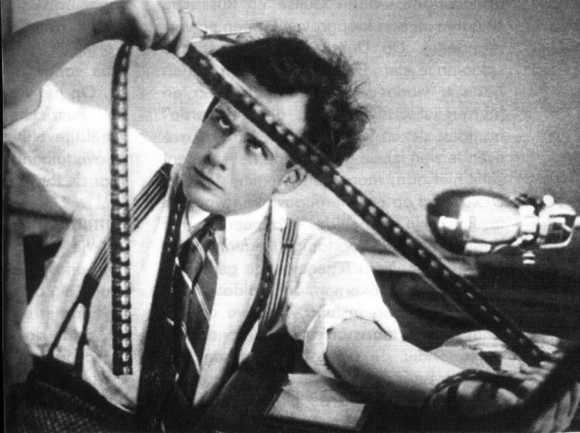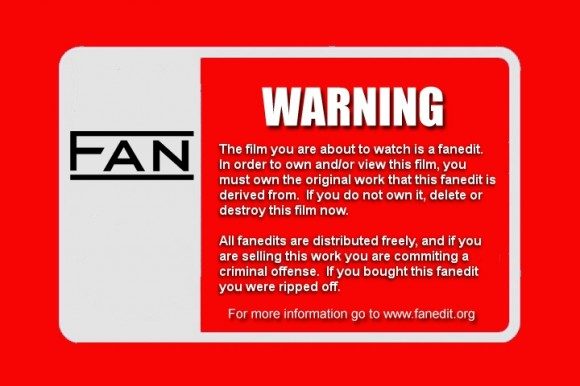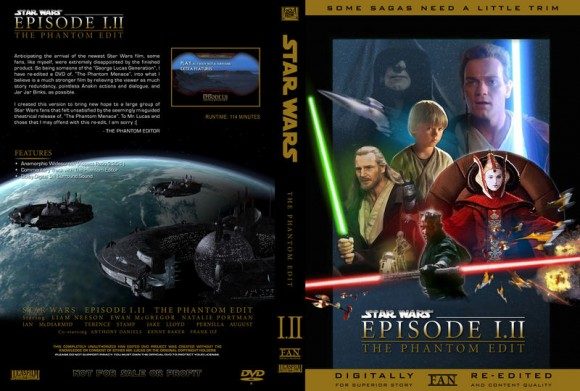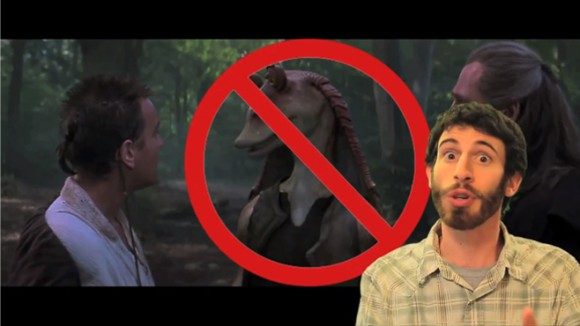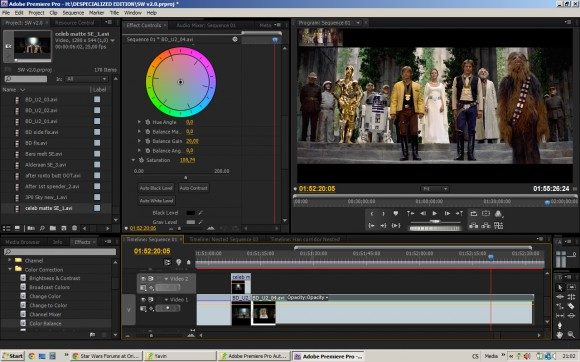Here’s a thought: fan edits represent the next stage in the evolution of film.
Okay, that’s a very, very big claim, and we’ll get back to that in a moment. First, some background. For the uninitiated, a “fan edit” of a movie is an alternate version of a feature film which has been re-edited, remixed, or in some other “re” way altered after its release by a member of the film-going public. They are differentiated from extended editions or special editions or remastered editions or other reissues of films by the fact that, as the title suggests, the changes that the film has undergone since its release have originated not with the film’s writers, directors, or even editors, but rather with a civilian who was not involved with the production. We’ll just call this person a fan.
The subcultural phenomenon that is fan edits is a very recent one. Before the turn of the millennium, fan edits would have been extremely difficult to make, would have looked and sounded considerably worse than their unaltered counterparts, and would have been practically impossible to mass reproduce. This all changed with the advent of prosumer video and editing software, which, like a filmmaking Prometheus, gave regular citizens the power to edit films at a professional level.
Most people first heard of fan edits when a re-edited version of Star Wars Episode I slithered its way into public awareness in 2000 and 2001. The project, aptly named The Phantom Edit, removed 18 minutes from the film’s running time, the bulks of it consisting of Jar-Jar antics, battle droid banter, and Jake Lloyd whooping noises. It received attention from several prominent filmmakers and news outlets, and since then communities that make, discuss, and freely trade fan edits have taken root, sprouted, and multiplied across the World Wide Web.
So what does a fan edit look like? Well, for starters not every film is a prime candidate for the process. It’s quite rare to see a fan edit of a films that enjoys mass popular acclaim or of universally despised movies. (so don’t hold your breath for those Gravity or Grown Ups 2 fan edits) Most of the time, fan edits target films in which large groups have some sort of investment… but which also have some points of contention. Classic examples of fan edits are things like The Two Towers: The Purist Edit, which removes about forty minutes of material that was not in the J.R.R. Tolkien books from the second Lord of the Rings film, or Blade Runner: The Nexus 6 Cut, which combines material from five, count ‘em, five released editions of the film into an extended cut that matches the shooting script more closely than any of the official versions.
The Star Wars prequels are in and of themselves a cottage industry in fan edits, with countless fan editors giving their own unique spin on how to address the myriad tonal, structural, logical, pacing, performance, and Jar-Jar issues that plague episodes one through three. Tackling the runts of the Jedi litter almost seems like a fan edit rite of passage, with database website fanedit.org listing information on no fewer than 24 distinct fan edits of The Phantom Menace.
For a long time, conventional wisdom was that fan editing was largely a subtractive art. Fans could remove offending shots or scenes and reorder material, but, unless the film had a wealth of available deleted scenes, there were no ways to introduce new content to existing films. But then, as usually happens when conventional wisdom rears its ugly head, people got really creative. Star Wars 30’s Serial Edition restructures footage from all prequels into silent, black and white short films that imitates the style of early film serials. With all dialogue handled through intertitles, the fan editor was able to tell the prequel stories with brand new dialogue and characterizations. Alternatively, in a series of highly popular videos, Belated Media has combined heavily edited footage, original storyboards, and an onscreen narrative “pitch” to offer very thorough reimaginings of Phantom Menace and Attack of the Clones. As more time goes by, more fans are finding ways to make their mutant versions of the films as successful as they possibly can.
And the fact of the matter is that certain fan edits are widely considered to be extremely successful. Anonymous fan editor L8wrtr’s cut of The Phantom Menace, The Shadow of the Sith, removes a whopping 40 minutes from the film’s runtime, going through a painstakingly detailed process of re-editing, re-sound mixing, and re-color correcting the film to reduce the Gungans’ presence, remove unnecessary and offending dialogue, eliminate logic leaps, improve pacing, and reframe the story to be thoroughly centered on Anakin. (amongst many, many, many other changes) The resulting cut has met with acclaim amongst fan editing circles, with certain fan reviewers going so far as to say that this edit does not just improve The Phantom Menace’s quality, it makes it into a good film on its own right.
Which brings us to the question of… are fan edits a good thing?
Purely from a film consumer’s point of view, the answer might be a resounding, “Uhhh… yes, duh!” Why wouldn’t you want a version of Episode I that does away with midicholorians and the childish tone, especially if the cuts are as seamless as they are in L8wrtr’s work? Well, it might not be so simple as that. For one thing, there’s an undeniable value in looking at a film as part of larger artistic context in the form of its creator’s canon. In other words, more than just The Phantom Menace, you might be interested in George Lucas’s The Phantom Menace. For followers of particulars auteurs or those who are interested in films as components of a cohesive body of work, fan edits are at best a distraction and at worst anathema.
But even if we don’t object to fan edits from a philosophical point of view, there’s a large can of worms that must be addressed. Subscribing to fan edit culture completely changes the way that we interface with a film. Before fan edits, the ways in which we could impact our experience of watching a film were pretty much limited to… turning it off halfway through. Now, if we want to watch The Phantom Menace, we have a choice of 25 different cuts of the film, each with different nuances of form and content. Do we watch the version that redubs all of Jar-Jar’s dialogue into an alien tongue or the one that makes it into an absurdist comedy or the silent version or… you get the idea.
The degree of audience involvement, consideration, and choice that goes into watching a film goes way up. Even if it’s just by the nature of choosing which version of the movie we want to see, we are defining the film we are watching. The boundary between the filmmaker and the audience starts to get very fuzzy. Suddenly, the viewer gets to dictate content, to cater the film experience they want to have to their liking. You could even say, after a fashion, that they become the final creator that collaborates on the film experience. The film viewer asks, “Is this film good or bad?” The film viewer on fan edits asks, “What can this film be?”
This is a major change in the nature of our cultural conversation about film. Most of our current rubrics for film evaluation are held together by the assumption that we all watch the same version of the film and derive subjective responses from that objectively uniform stimulus. Fan edit culture forces us to rethink that, to ask: how can we critically evaluate a property while it is still in an ongoing state of flux? The Phantom Menace was released 15 years ago, but thanks to fan editors that keep producing new cuts of it, the making of it is kind of not yet done. The onus of finding meaning in and interpreting a film is thrust onto the viewer – it’s “Death of the Author” taken to a hilarious new extreme for the 21st Century.
For the time being, the growing fan editor subculture is exactly that – a subculture. We are not likely to see the kind of thinking that is the norm in the message boards of these websites taking over the mainstream anytime soon. But what is worth noting is that while mainstream movie news outlets focus on the impact of 3D and 48fps on filmmaking, there is a cultural revolution quietly happening that is altering the relationship between film and viewer on a much more fundamental level. We are seeing viewers who are going from observers of a finished product to participants in an ongoing, collective process. Regardless of how much staying power it may or may not have, we are witnessing one of the first major paradigm shifts in the art form, an event that challenges our manner of watching and talking about films in a deeper way than anything we’ve seen before.

